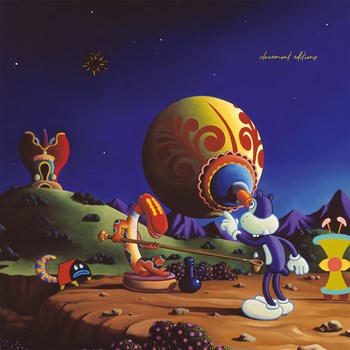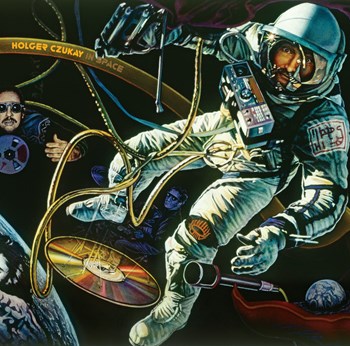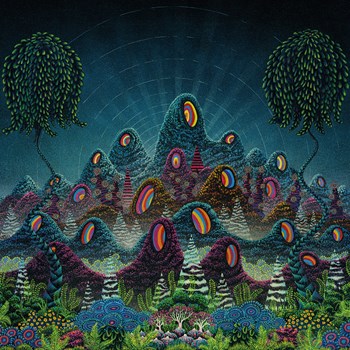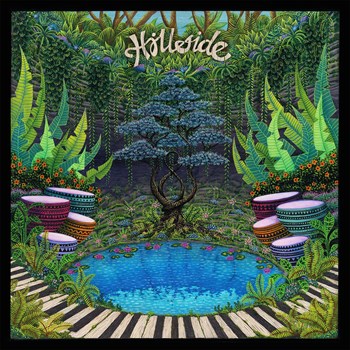Homegrown Music - Interview with Paul 'Mudd' Murphy from Claremont 56 records
Wednesday, October 20, 2021
by Tat
Claremont 56 is one of those rare labels that just seems to serve up exquisite releases that are not just beautiful to the ear but also to the eye. Label boss Paul ‘Mudd’ Murphy has a long track record of being involved in exciting and inventive collaborations including Bison, Akwaaba and Smith & Mudd to name but a very few. The hub of all of this activity is Claremont 56, one of the most discerning independent record labels of the last 15 years. Throw Leng (which he runs with Simon Purnell) and Spacetalk Records into the mix (Simon and Danny McLewin), along with Murphy’s own releases, there is a rich discography for new and old fans to delve into. Therefore, we were really quite pleased when Paul agreed to chat to us at Trackhunter.
First of all, what’s the story behind the label name Claremont 56, I note it’s also the title of your Mudd LP from 2007?
‘56 Claremont' in Bricket Wood is the address of the house I grew up in from the age of 9-years-old. It was a typical small terraced house and the home of my first ever bedroom studio. This was the first place I made music and where Tom Lee and Steve Kotey and I formed Akwaaba and wrote our first album 'Do It Tomorrow'
When I wrote my solo album and titled it, I had no idea that I would start a label, but very shortly after it's release I decided to give it a go and Claremont 56 felt like the natural name for the label, although it did initially cause a bit of confusion.

It’s hard to pigeonhole Claremont 56, but the music has a very beautiful thread running throughout it. In a nutshell what would you say to someone who had not heard of your label as to what it is and how it sounds?
I get asked this question all the time, quite often by people who have no idea about the music scene and genres, and I always wish I had a good, succinct answer, but sadly I don't. I find it really tricky to explain at all, let alone in a nutshell. I tend to say that it's a mix of mellow music, that's a bit dancey – a bit West Coast rock, a bit disco, as well as being a bit jazzy, but also has a prog influence.
Most people describe it as 'Balearic', which is also pretty hard to explain to someone. The closest I can see to describing it in a nutshell is to say that it's pleasant music to listen to, (hopefully) without feeling too mainstream.
Your collaboration with Ben Smith under the guise of Smith & Mudd (and as part of Bison) has borne many releases, particularly on Claremont 56. How did that collaboration come about and was it integral to you starting the label?
Ben has been there from the start. We're like musical brothers, who have been on all sorts of journeys together – musically and in our personal lives. Relationship break-ups, career confidence highs and lows and of course a lot of time in the studio working together. We first met in Nottingham when Tom, Steve and I were making the second Akwaaba album, 'Keep It Shiny' and we needed some acoustic guitar for one of the tracks. Friends in Nottingham brought Ben in to do a session for us, which went really well. Ben and I got on instantly and we continued to chat and work together and after a couple of years, made and released our first couple of tracks with Huw Costin (from Torn Sail). We wrote 'Sci Fi' first, but our second track 'Blue River' was our first track to be released which was signed to the Idjut Boys’ label 'Discfunction'. We then went on to release three albums on Claremont 56 – 'Blue River' (which featured our first track 'Sci Fi' as a bonus track), 'Le Suivant' and 'Gorthleck'.

You have been involved in a couple of interesting collaborations, including Bison which resulted in working with Ursula Kloss and the Can legend Holgar Czukay in his Cologne studio. That must have been quite some experience?
Working with Ursa and Holger at the Innerspace studios - two eccentric and beautifully creative people - had a huge impact on me. Being part of their wonderfully strange world was a humbling and life changing experience. It was an incredible space, with so much musical history. It was a three storey open room, which was very dark, as there were no windows, with burgundy drapes from floor to ceiling and the only light came from subtle lighting. The overall effect meant that you lost all sense of time when you were there.
What did you learn from that period of making music, did it change anything about what you did as a musician and as a label owner?
I learnt a lot from both of them. Ursa from a business perspective, as she had been handling Holger's catalogue for a long time when we first spoke. She taught me about the importance of being more protective of my music. At that time I'd happily hand anything over anything to any compilation, as I was just flattered that my music was even being considered for use, but Ursa made me realise that sometimes it pays to be more selective and set a minimum and stick to it, to give value to the music. Holger taught me not to be too precious about things being perfect. He thrived on mistakes and "wrong" notes and would often say "There are no mistakes Paul" when we were working on music together.
When I think about it and when I look back at photos, I can't actually believe it all happened, it was like being in another world. Over time we developed a great friendship and I would speak to them both two or three times a week. I really miss them both.
Your musical journey started way before that, as I gather you were originally into early 1980’s U.S Electro. At what point did you move on from being a purveyor of music to DJing and then producing your own tracks?
It was something I never thought about really until I met the Idjut Boys at their fantastic 'Phreeek' nights at the Cross in Kings Cross, in 1994/5. I went to all of their monthly parties and after nervously passing a mixtape to Conrad (McDonnell) one night, we got to know each other through partying. Once we became friends, we spoke to them about the ideas we had for parties and music we wanted to create. They introduced us to DJs like Victor Simonelli, who DJ'd at one of our 'For Those Who Like to Groove' parties and advised us on some initial equipment to buy (we started with A Roland JV1080). Their advice and support suddenly made it all seem possible and we got to work. At the same time a friend of ours had a great little record shop in Hemel Hempstead and was messing about with an early version of 'Cubase' (90's version of Logic) on a Mac. He taught us how to use it and we bought a copy and started off with one of those tall macs with the tiny screen and the JV1080. Our first demos were musical but pretty basic and Conrad advised us to get a sampler, which is when it really started happening. We then enlisted the aid of a great keyboard player, Lawrence Ee and 'Akwaaba - Just Pilau' was born.

The releases on Claremont 56 are very eye-catching and beautifully packaged, how important is that element to what you are trying to achieve?
I think the music is more important of course, but for me the packaging also plays a part in making something special. I have always had a fascination with beautiful looking record sleeves from my early years and collecting affordable art, plus I trained as a typographer and worked as a Graphic Designer for 15 years before I set up the label, so to me, it just feels like the natural thing to do.
Do you work with the same graphic artists as some releases have the same warm, psychedelic feel to their artwork?
Mark Warrington is my main artist. He sums up what I'm trying to achieve, but his amazing original paintings take time, so it would be impossible to have his work on every cover. There's a certain from-nature feel to all the covers, in fact on recent reflection, the majority seem to feature trees and I guess this comes from growing up with woods around me and having a love for nature. I really love sourcing artists for the Editions series. They're people who I've followed and admired over the years and it's great to have something of theirs on the label and sold as a limited edition collectible piece.
You’ve got an established stable of international artists such as Almunia from Italy, Jack Cutter from the United States and Jpye in France. How do you discover these artists?
They all have their own stories of how they end up on the label. Some have been friends of mine for a long time, some are friends of friends and others are straight demos from people who admire the label. Months and months will pass without any music and then all of a sudden I'll have a couple of new artists and tracks and I will start to think about a release. The excitement of getting a new release together still feels as exciting as when I first started and it's brilliant getting to know new people from around the world and hearing their stories of how they got into music and writing.

Your latest project is Hillside and the vibrant album Sunday In June which came about after the restrictions brought about by the pandemic. Did you find yourself investing more time and energy in this album than you normally would give the lack of other normal creative outlets?
It definitely benefited by being at home a lot more than usual. I find it hard to spend any length of constant time in the studio these days, as there are always so many distractions. The music for Sunday in June was flowing between us really quickly via file sharing, as everyone involved had more time on their hands. Plus we had the added bonus of a wealth of new parts to add to each track when they came back from Michele Chiavarini who played all of the incredible keyboards that are featured. I often run out of things to do on a track quite quickly and get stumped, but the files just kept coming and the production/arrangement was incredibly exciting as there was always something to do.
You collaborated on Sunday In June with Alex Searle and Patrick Dawes, two musicians you have worked with before. How important was it to make this record with a shared feeling of escapism - when like the rest of us - you were all going through an uncertain time in lockdown.
I felt pretty lucky to have such a shared feeling of creativity between us and the excitement that something really good was happening. It has been a while since I've had that feeling from making music and with what was going on around the world, I felt very lucky to have some proper escapism from the news of the pandemic.
You also co-run Leng Records, does being involved in other labels give you a greater flexibility to explore a wider range of sounds and what’s next for these imprints?
When Simon (Purnell) and I started Leng it was more of an open brief to do whatever we wanted to do and we have found the label's groove as a mid tempo chuggy style of music, which is great. We seem to be getting bigger names on the label now, which is also attracting new artists to send us demos and we've had some quality bits through the door recently. The Ron Trent remixes of Harks & Mudd - Susta is out next week. We have an Emperor Machine 12" after that and an album from Lex from Athens, ready to go.
What plans do you have as an artist going forward and what’s next for Claremont 56?
I've never really had a plan for Claremont 56, as long as good music comes in, then I'll release it and I hope that will always be the case. The latest album I'm working on for the label is the third volume of Editions and that is slowly getting coming together.
As an artist, I'm working on the second Hillside album with Alex and Patrick. I've had a good break from writing, so I'm also looking for something new to do - maybe a second solo album some time in the future.
Where do you discover new music to listen to these days and what kind of things are doing it for you at the moment?
I don't get to do much digging these days, so lots of it is hanging out with friends and sharing music with each other. I went to the We Out Here festival at the end of August and it reminded me how much good new and old music that I have yet to hear. It was really inspiring and gave me a kick up the butt to work harder to find and listen to more. I do find a lot on Bandcamp, which I think is brilliant, as well as ending up in a lot of Discogs rabbit holes.
I really liked the John Carol Kirby & the Eddie Chacon albums, they're the last modern LPs I've bought and can't wait to see them at the Rio Cinema in November.
Claremont 56 Records
Claremont Records on Facebook
Leng Records
Spacetalk Records
Paul Murphy on Discogs
Discover new digital dance music with Trackhunter








